KFC Marketing Plan: Strategies for Success in the UK Fast Food Market
VerifiedAdded on 2023/06/04
|12
|3367
|420
Report
AI Summary
This report provides an analysis of KFC's marketing strategies, focusing on its operations within the UK market. It examines the competitive landscape, noting key players like Subway, McDonald's, and Burger King, and highlights KFC's ability to maintain market leadership through strategic adaptation. The report details KFC's use of geographic, psychographic, and demographic segmentation to target diverse customer groups. It also explores the company's marketing mix, including product offerings, pricing strategies, placement tactics, and promotional activities. The analysis further covers KFC's branding efforts, supply chain management, and responses to the marketing environment, including competition and consumer preferences. The report concludes by emphasizing KFC's focus on customer relationships and continuous improvement through feedback mechanisms.
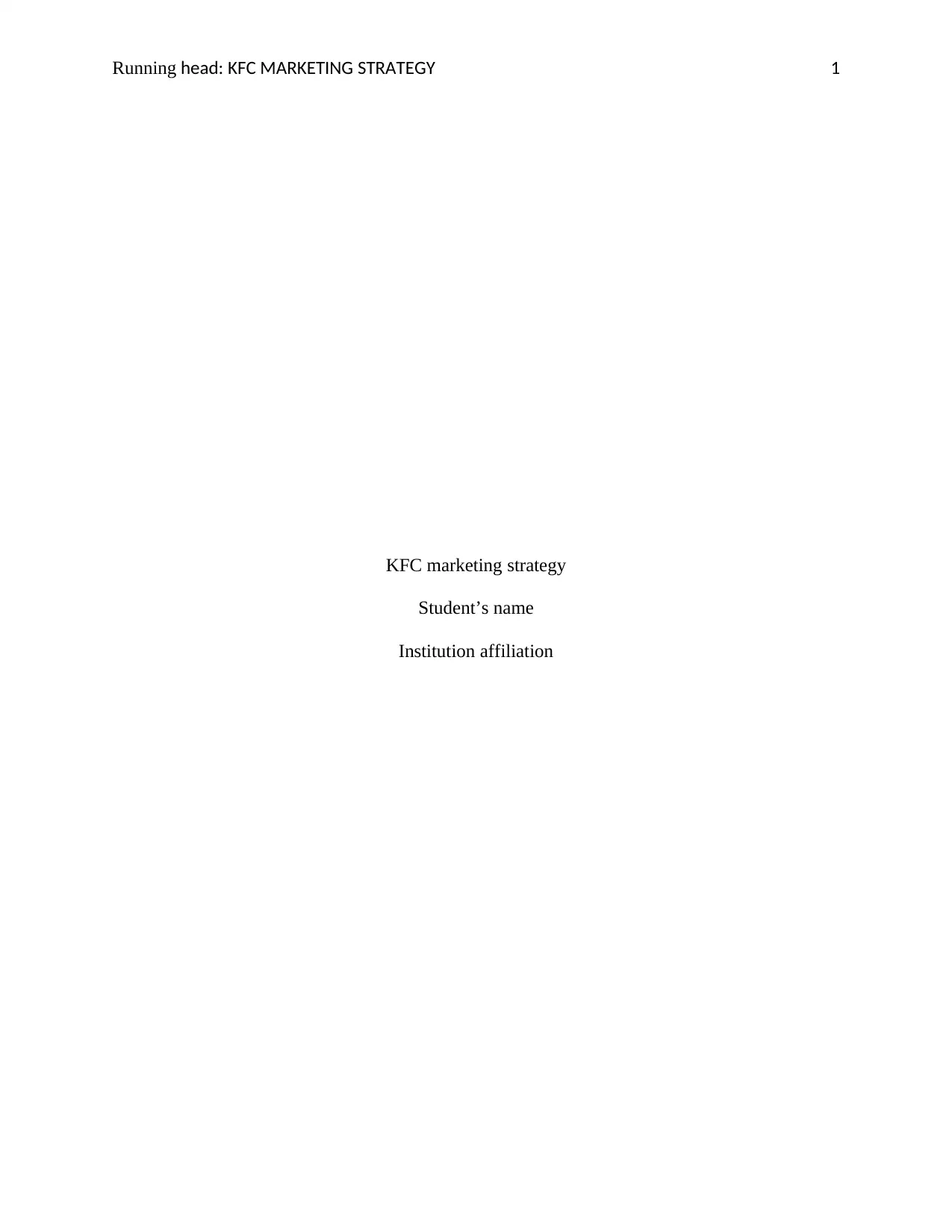
Running head: KFC MARKETING STRATEGY 1
KFC marketing strategy
Student’s name
Institution affiliation
KFC marketing strategy
Student’s name
Institution affiliation
Secure Best Marks with AI Grader
Need help grading? Try our AI Grader for instant feedback on your assignments.
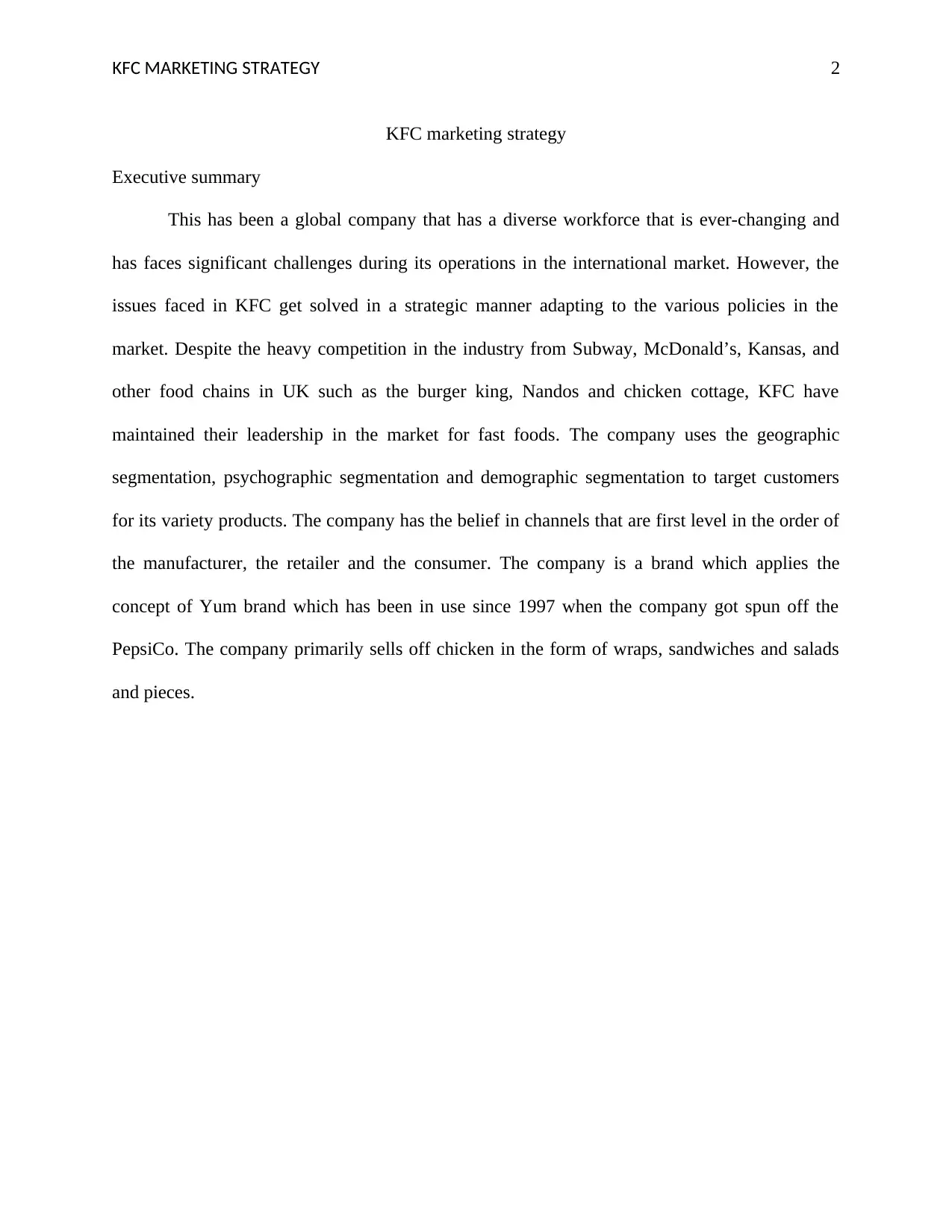
KFC MARKETING STRATEGY 2
KFC marketing strategy
Executive summary
This has been a global company that has a diverse workforce that is ever-changing and
has faces significant challenges during its operations in the international market. However, the
issues faced in KFC get solved in a strategic manner adapting to the various policies in the
market. Despite the heavy competition in the industry from Subway, McDonald’s, Kansas, and
other food chains in UK such as the burger king, Nandos and chicken cottage, KFC have
maintained their leadership in the market for fast foods. The company uses the geographic
segmentation, psychographic segmentation and demographic segmentation to target customers
for its variety products. The company has the belief in channels that are first level in the order of
the manufacturer, the retailer and the consumer. The company is a brand which applies the
concept of Yum brand which has been in use since 1997 when the company got spun off the
PepsiCo. The company primarily sells off chicken in the form of wraps, sandwiches and salads
and pieces.
KFC marketing strategy
Executive summary
This has been a global company that has a diverse workforce that is ever-changing and
has faces significant challenges during its operations in the international market. However, the
issues faced in KFC get solved in a strategic manner adapting to the various policies in the
market. Despite the heavy competition in the industry from Subway, McDonald’s, Kansas, and
other food chains in UK such as the burger king, Nandos and chicken cottage, KFC have
maintained their leadership in the market for fast foods. The company uses the geographic
segmentation, psychographic segmentation and demographic segmentation to target customers
for its variety products. The company has the belief in channels that are first level in the order of
the manufacturer, the retailer and the consumer. The company is a brand which applies the
concept of Yum brand which has been in use since 1997 when the company got spun off the
PepsiCo. The company primarily sells off chicken in the form of wraps, sandwiches and salads
and pieces.
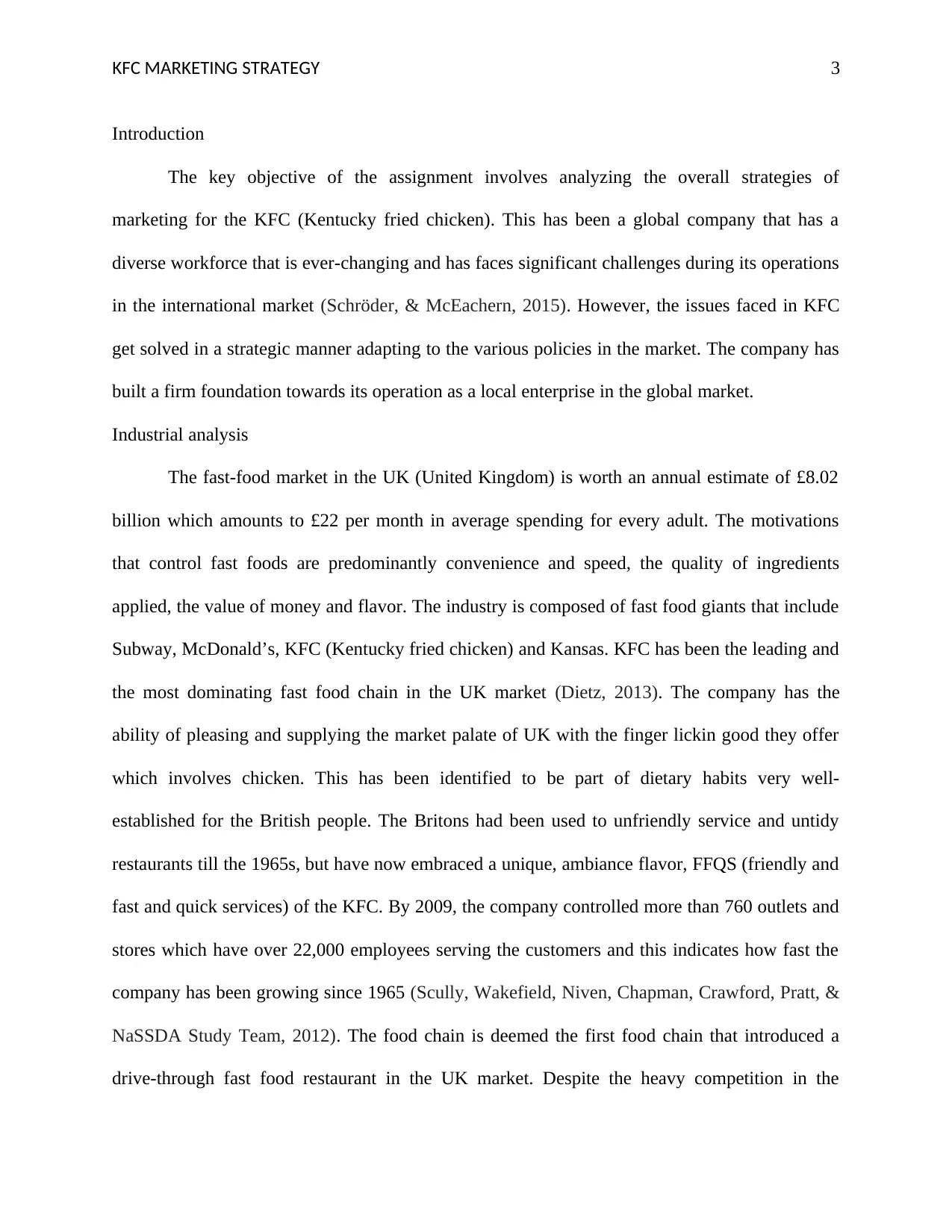
KFC MARKETING STRATEGY 3
Introduction
The key objective of the assignment involves analyzing the overall strategies of
marketing for the KFC (Kentucky fried chicken). This has been a global company that has a
diverse workforce that is ever-changing and has faces significant challenges during its operations
in the international market (Schröder, & McEachern, 2015). However, the issues faced in KFC
get solved in a strategic manner adapting to the various policies in the market. The company has
built a firm foundation towards its operation as a local enterprise in the global market.
Industrial analysis
The fast-food market in the UK (United Kingdom) is worth an annual estimate of £8.02
billion which amounts to £22 per month in average spending for every adult. The motivations
that control fast foods are predominantly convenience and speed, the quality of ingredients
applied, the value of money and flavor. The industry is composed of fast food giants that include
Subway, McDonald’s, KFC (Kentucky fried chicken) and Kansas. KFC has been the leading and
the most dominating fast food chain in the UK market (Dietz, 2013). The company has the
ability of pleasing and supplying the market palate of UK with the finger lickin good they offer
which involves chicken. This has been identified to be part of dietary habits very well-
established for the British people. The Britons had been used to unfriendly service and untidy
restaurants till the 1965s, but have now embraced a unique, ambiance flavor, FFQS (friendly and
fast and quick services) of the KFC. By 2009, the company controlled more than 760 outlets and
stores which have over 22,000 employees serving the customers and this indicates how fast the
company has been growing since 1965 (Scully, Wakefield, Niven, Chapman, Crawford, Pratt, &
NaSSDA Study Team, 2012). The food chain is deemed the first food chain that introduced a
drive-through fast food restaurant in the UK market. Despite the heavy competition in the
Introduction
The key objective of the assignment involves analyzing the overall strategies of
marketing for the KFC (Kentucky fried chicken). This has been a global company that has a
diverse workforce that is ever-changing and has faces significant challenges during its operations
in the international market (Schröder, & McEachern, 2015). However, the issues faced in KFC
get solved in a strategic manner adapting to the various policies in the market. The company has
built a firm foundation towards its operation as a local enterprise in the global market.
Industrial analysis
The fast-food market in the UK (United Kingdom) is worth an annual estimate of £8.02
billion which amounts to £22 per month in average spending for every adult. The motivations
that control fast foods are predominantly convenience and speed, the quality of ingredients
applied, the value of money and flavor. The industry is composed of fast food giants that include
Subway, McDonald’s, KFC (Kentucky fried chicken) and Kansas. KFC has been the leading and
the most dominating fast food chain in the UK market (Dietz, 2013). The company has the
ability of pleasing and supplying the market palate of UK with the finger lickin good they offer
which involves chicken. This has been identified to be part of dietary habits very well-
established for the British people. The Britons had been used to unfriendly service and untidy
restaurants till the 1965s, but have now embraced a unique, ambiance flavor, FFQS (friendly and
fast and quick services) of the KFC. By 2009, the company controlled more than 760 outlets and
stores which have over 22,000 employees serving the customers and this indicates how fast the
company has been growing since 1965 (Scully, Wakefield, Niven, Chapman, Crawford, Pratt, &
NaSSDA Study Team, 2012). The food chain is deemed the first food chain that introduced a
drive-through fast food restaurant in the UK market. Despite the heavy competition in the
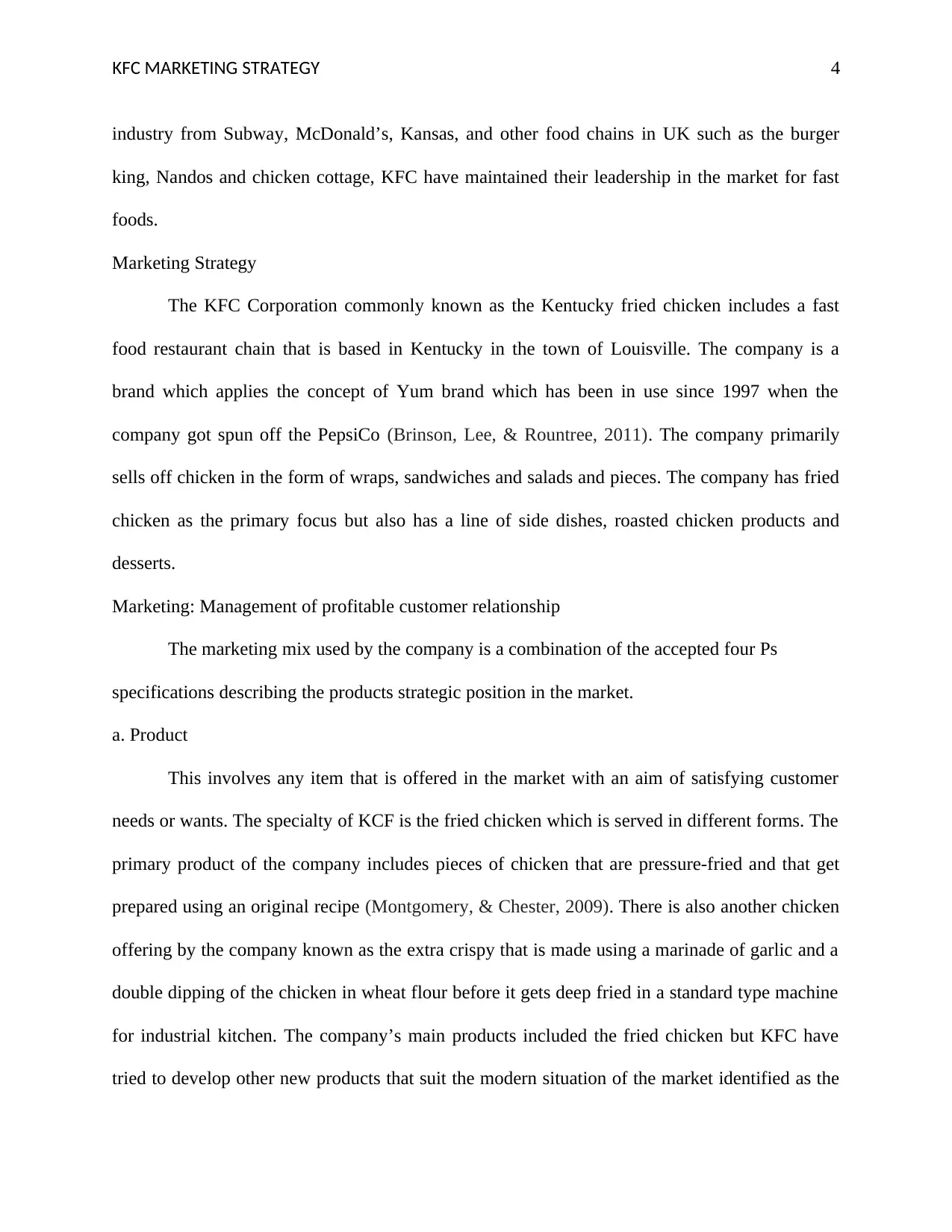
KFC MARKETING STRATEGY 4
industry from Subway, McDonald’s, Kansas, and other food chains in UK such as the burger
king, Nandos and chicken cottage, KFC have maintained their leadership in the market for fast
foods.
Marketing Strategy
The KFC Corporation commonly known as the Kentucky fried chicken includes a fast
food restaurant chain that is based in Kentucky in the town of Louisville. The company is a
brand which applies the concept of Yum brand which has been in use since 1997 when the
company got spun off the PepsiCo (Brinson, Lee, & Rountree, 2011). The company primarily
sells off chicken in the form of wraps, sandwiches and salads and pieces. The company has fried
chicken as the primary focus but also has a line of side dishes, roasted chicken products and
desserts.
Marketing: Management of profitable customer relationship
The marketing mix used by the company is a combination of the accepted four Ps
specifications describing the products strategic position in the market.
a. Product
This involves any item that is offered in the market with an aim of satisfying customer
needs or wants. The specialty of KCF is the fried chicken which is served in different forms. The
primary product of the company includes pieces of chicken that are pressure-fried and that get
prepared using an original recipe (Montgomery, & Chester, 2009). There is also another chicken
offering by the company known as the extra crispy that is made using a marinade of garlic and a
double dipping of the chicken in wheat flour before it gets deep fried in a standard type machine
for industrial kitchen. The company’s main products included the fried chicken but KFC have
tried to develop other new products that suit the modern situation of the market identified as the
industry from Subway, McDonald’s, Kansas, and other food chains in UK such as the burger
king, Nandos and chicken cottage, KFC have maintained their leadership in the market for fast
foods.
Marketing Strategy
The KFC Corporation commonly known as the Kentucky fried chicken includes a fast
food restaurant chain that is based in Kentucky in the town of Louisville. The company is a
brand which applies the concept of Yum brand which has been in use since 1997 when the
company got spun off the PepsiCo (Brinson, Lee, & Rountree, 2011). The company primarily
sells off chicken in the form of wraps, sandwiches and salads and pieces. The company has fried
chicken as the primary focus but also has a line of side dishes, roasted chicken products and
desserts.
Marketing: Management of profitable customer relationship
The marketing mix used by the company is a combination of the accepted four Ps
specifications describing the products strategic position in the market.
a. Product
This involves any item that is offered in the market with an aim of satisfying customer
needs or wants. The specialty of KCF is the fried chicken which is served in different forms. The
primary product of the company includes pieces of chicken that are pressure-fried and that get
prepared using an original recipe (Montgomery, & Chester, 2009). There is also another chicken
offering by the company known as the extra crispy that is made using a marinade of garlic and a
double dipping of the chicken in wheat flour before it gets deep fried in a standard type machine
for industrial kitchen. The company’s main products included the fried chicken but KFC have
tried to develop other new products that suit the modern situation of the market identified as the
Secure Best Marks with AI Grader
Need help grading? Try our AI Grader for instant feedback on your assignments.
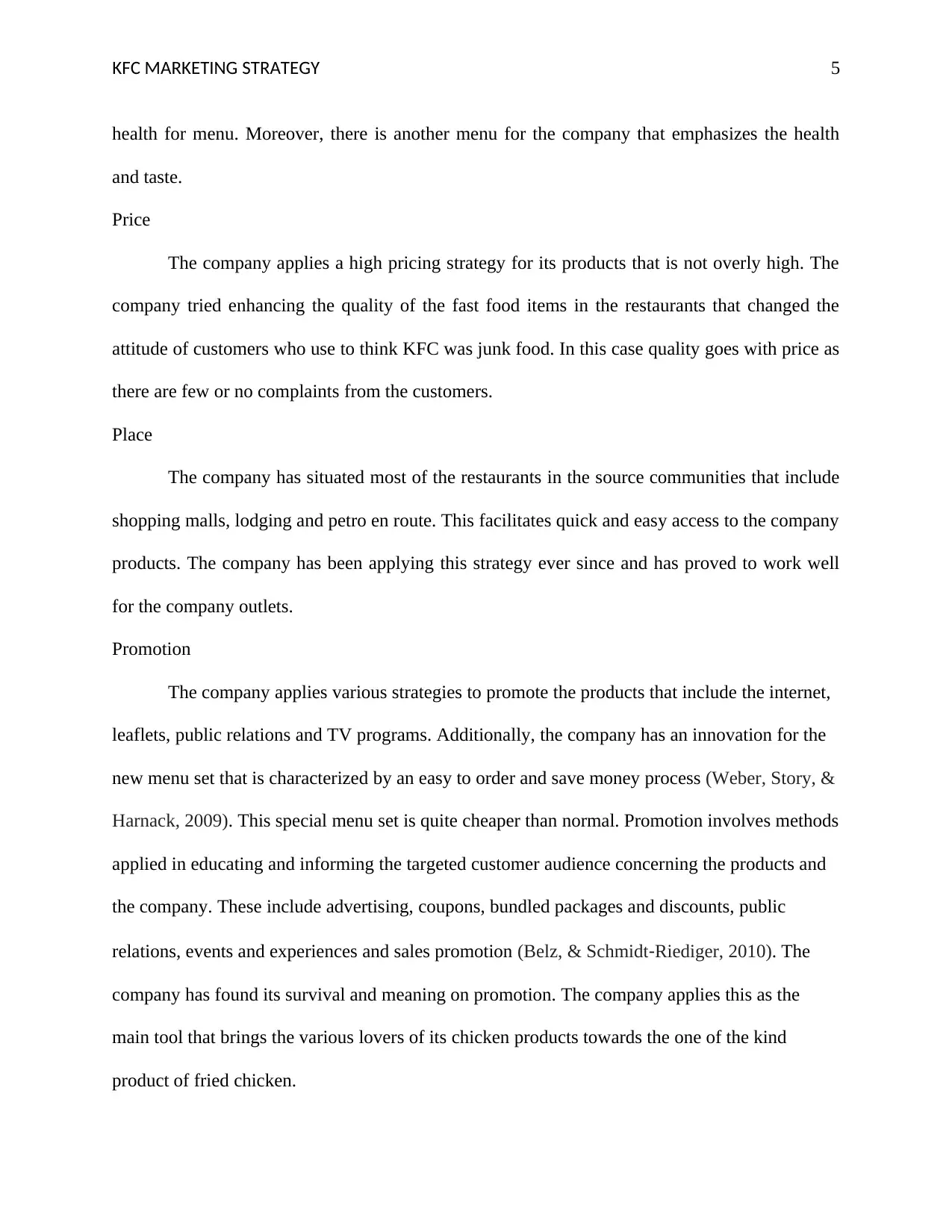
KFC MARKETING STRATEGY 5
health for menu. Moreover, there is another menu for the company that emphasizes the health
and taste.
Price
The company applies a high pricing strategy for its products that is not overly high. The
company tried enhancing the quality of the fast food items in the restaurants that changed the
attitude of customers who use to think KFC was junk food. In this case quality goes with price as
there are few or no complaints from the customers.
Place
The company has situated most of the restaurants in the source communities that include
shopping malls, lodging and petro en route. This facilitates quick and easy access to the company
products. The company has been applying this strategy ever since and has proved to work well
for the company outlets.
Promotion
The company applies various strategies to promote the products that include the internet,
leaflets, public relations and TV programs. Additionally, the company has an innovation for the
new menu set that is characterized by an easy to order and save money process (Weber, Story, &
Harnack, 2009). This special menu set is quite cheaper than normal. Promotion involves methods
applied in educating and informing the targeted customer audience concerning the products and
the company. These include advertising, coupons, bundled packages and discounts, public
relations, events and experiences and sales promotion (Belz, & Schmidt‐Riediger, 2010). The
company has found its survival and meaning on promotion. The company applies this as the
main tool that brings the various lovers of its chicken products towards the one of the kind
product of fried chicken.
health for menu. Moreover, there is another menu for the company that emphasizes the health
and taste.
Price
The company applies a high pricing strategy for its products that is not overly high. The
company tried enhancing the quality of the fast food items in the restaurants that changed the
attitude of customers who use to think KFC was junk food. In this case quality goes with price as
there are few or no complaints from the customers.
Place
The company has situated most of the restaurants in the source communities that include
shopping malls, lodging and petro en route. This facilitates quick and easy access to the company
products. The company has been applying this strategy ever since and has proved to work well
for the company outlets.
Promotion
The company applies various strategies to promote the products that include the internet,
leaflets, public relations and TV programs. Additionally, the company has an innovation for the
new menu set that is characterized by an easy to order and save money process (Weber, Story, &
Harnack, 2009). This special menu set is quite cheaper than normal. Promotion involves methods
applied in educating and informing the targeted customer audience concerning the products and
the company. These include advertising, coupons, bundled packages and discounts, public
relations, events and experiences and sales promotion (Belz, & Schmidt‐Riediger, 2010). The
company has found its survival and meaning on promotion. The company applies this as the
main tool that brings the various lovers of its chicken products towards the one of the kind
product of fried chicken.
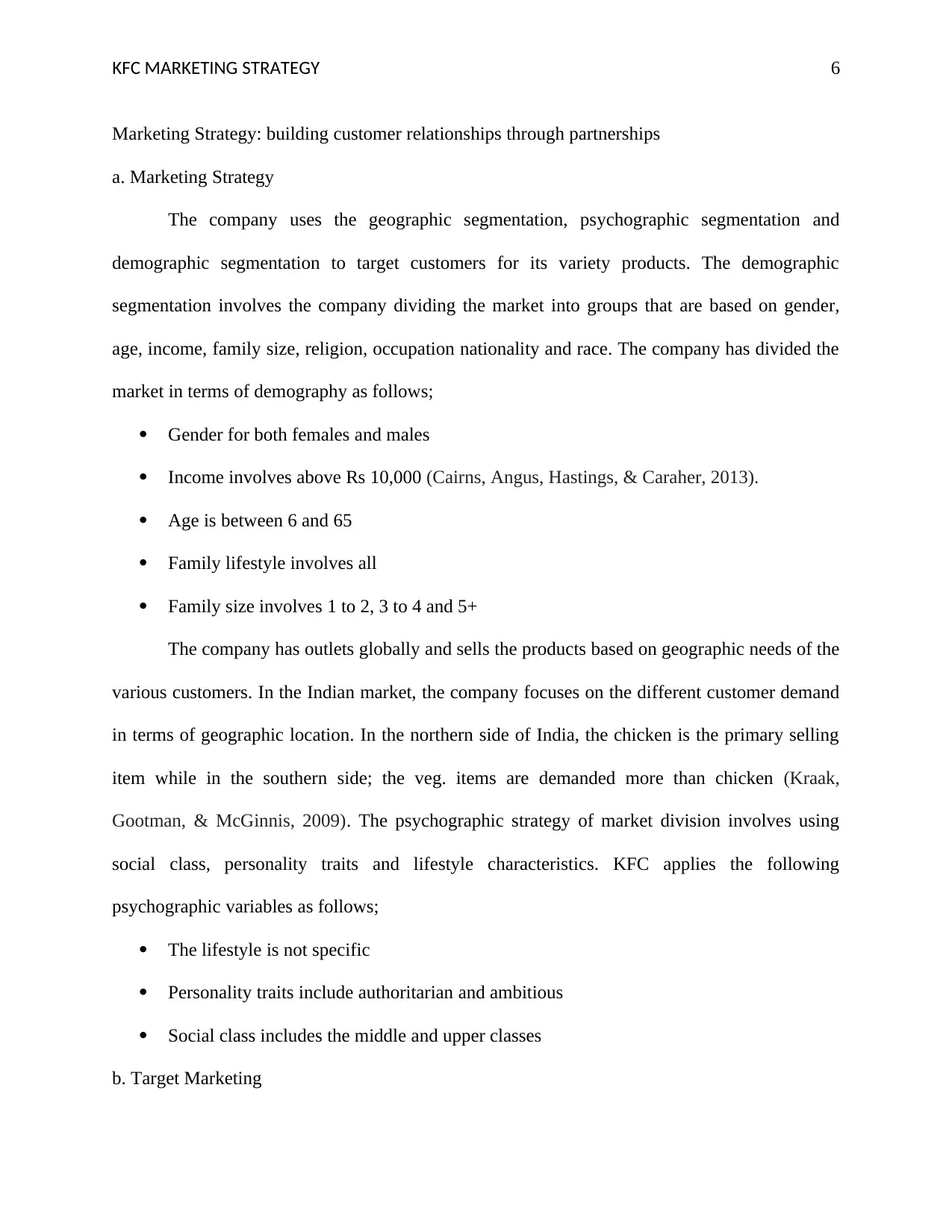
KFC MARKETING STRATEGY 6
Marketing Strategy: building customer relationships through partnerships
a. Marketing Strategy
The company uses the geographic segmentation, psychographic segmentation and
demographic segmentation to target customers for its variety products. The demographic
segmentation involves the company dividing the market into groups that are based on gender,
age, income, family size, religion, occupation nationality and race. The company has divided the
market in terms of demography as follows;
Gender for both females and males
Income involves above Rs 10,000 (Cairns, Angus, Hastings, & Caraher, 2013).
Age is between 6 and 65
Family lifestyle involves all
Family size involves 1 to 2, 3 to 4 and 5+
The company has outlets globally and sells the products based on geographic needs of the
various customers. In the Indian market, the company focuses on the different customer demand
in terms of geographic location. In the northern side of India, the chicken is the primary selling
item while in the southern side; the veg. items are demanded more than chicken (Kraak,
Gootman, & McGinnis, 2009). The psychographic strategy of market division involves using
social class, personality traits and lifestyle characteristics. KFC applies the following
psychographic variables as follows;
The lifestyle is not specific
Personality traits include authoritarian and ambitious
Social class includes the middle and upper classes
b. Target Marketing
Marketing Strategy: building customer relationships through partnerships
a. Marketing Strategy
The company uses the geographic segmentation, psychographic segmentation and
demographic segmentation to target customers for its variety products. The demographic
segmentation involves the company dividing the market into groups that are based on gender,
age, income, family size, religion, occupation nationality and race. The company has divided the
market in terms of demography as follows;
Gender for both females and males
Income involves above Rs 10,000 (Cairns, Angus, Hastings, & Caraher, 2013).
Age is between 6 and 65
Family lifestyle involves all
Family size involves 1 to 2, 3 to 4 and 5+
The company has outlets globally and sells the products based on geographic needs of the
various customers. In the Indian market, the company focuses on the different customer demand
in terms of geographic location. In the northern side of India, the chicken is the primary selling
item while in the southern side; the veg. items are demanded more than chicken (Kraak,
Gootman, & McGinnis, 2009). The psychographic strategy of market division involves using
social class, personality traits and lifestyle characteristics. KFC applies the following
psychographic variables as follows;
The lifestyle is not specific
Personality traits include authoritarian and ambitious
Social class includes the middle and upper classes
b. Target Marketing
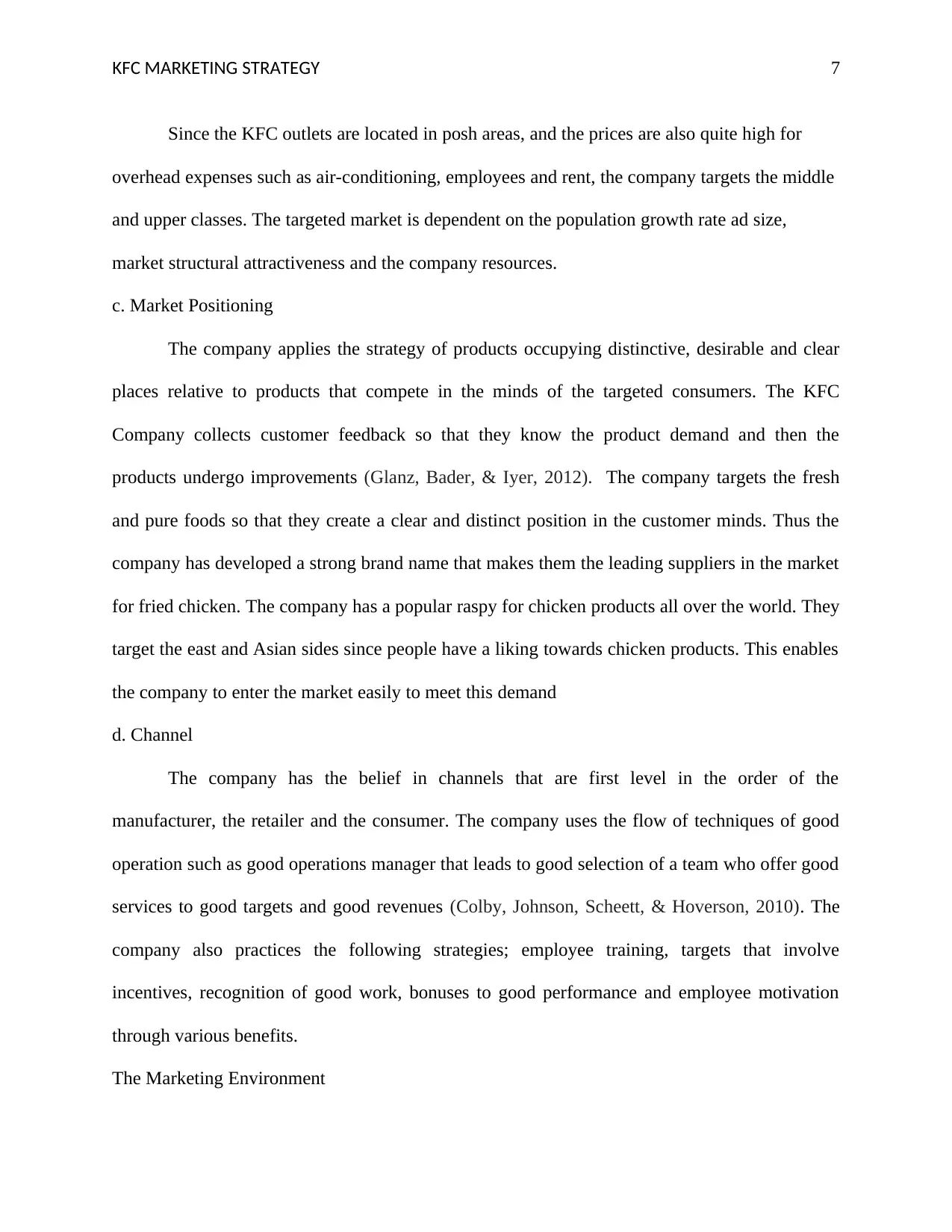
KFC MARKETING STRATEGY 7
Since the KFC outlets are located in posh areas, and the prices are also quite high for
overhead expenses such as air-conditioning, employees and rent, the company targets the middle
and upper classes. The targeted market is dependent on the population growth rate ad size,
market structural attractiveness and the company resources.
c. Market Positioning
The company applies the strategy of products occupying distinctive, desirable and clear
places relative to products that compete in the minds of the targeted consumers. The KFC
Company collects customer feedback so that they know the product demand and then the
products undergo improvements (Glanz, Bader, & Iyer, 2012). The company targets the fresh
and pure foods so that they create a clear and distinct position in the customer minds. Thus the
company has developed a strong brand name that makes them the leading suppliers in the market
for fried chicken. The company has a popular raspy for chicken products all over the world. They
target the east and Asian sides since people have a liking towards chicken products. This enables
the company to enter the market easily to meet this demand
d. Channel
The company has the belief in channels that are first level in the order of the
manufacturer, the retailer and the consumer. The company uses the flow of techniques of good
operation such as good operations manager that leads to good selection of a team who offer good
services to good targets and good revenues (Colby, Johnson, Scheett, & Hoverson, 2010). The
company also practices the following strategies; employee training, targets that involve
incentives, recognition of good work, bonuses to good performance and employee motivation
through various benefits.
The Marketing Environment
Since the KFC outlets are located in posh areas, and the prices are also quite high for
overhead expenses such as air-conditioning, employees and rent, the company targets the middle
and upper classes. The targeted market is dependent on the population growth rate ad size,
market structural attractiveness and the company resources.
c. Market Positioning
The company applies the strategy of products occupying distinctive, desirable and clear
places relative to products that compete in the minds of the targeted consumers. The KFC
Company collects customer feedback so that they know the product demand and then the
products undergo improvements (Glanz, Bader, & Iyer, 2012). The company targets the fresh
and pure foods so that they create a clear and distinct position in the customer minds. Thus the
company has developed a strong brand name that makes them the leading suppliers in the market
for fried chicken. The company has a popular raspy for chicken products all over the world. They
target the east and Asian sides since people have a liking towards chicken products. This enables
the company to enter the market easily to meet this demand
d. Channel
The company has the belief in channels that are first level in the order of the
manufacturer, the retailer and the consumer. The company uses the flow of techniques of good
operation such as good operations manager that leads to good selection of a team who offer good
services to good targets and good revenues (Colby, Johnson, Scheett, & Hoverson, 2010). The
company also practices the following strategies; employee training, targets that involve
incentives, recognition of good work, bonuses to good performance and employee motivation
through various benefits.
The Marketing Environment
Paraphrase This Document
Need a fresh take? Get an instant paraphrase of this document with our AI Paraphraser
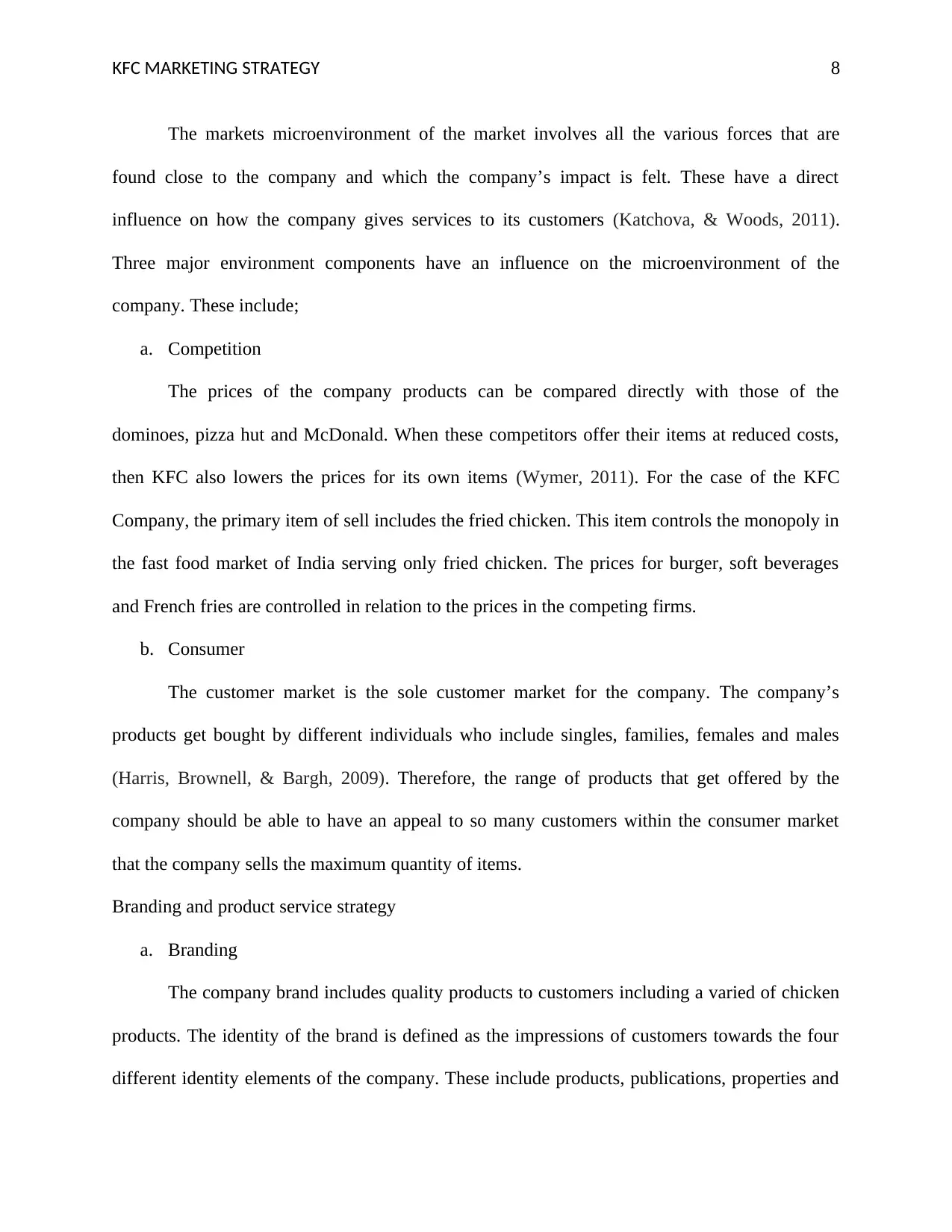
KFC MARKETING STRATEGY 8
The markets microenvironment of the market involves all the various forces that are
found close to the company and which the company’s impact is felt. These have a direct
influence on how the company gives services to its customers (Katchova, & Woods, 2011).
Three major environment components have an influence on the microenvironment of the
company. These include;
a. Competition
The prices of the company products can be compared directly with those of the
dominoes, pizza hut and McDonald. When these competitors offer their items at reduced costs,
then KFC also lowers the prices for its own items (Wymer, 2011). For the case of the KFC
Company, the primary item of sell includes the fried chicken. This item controls the monopoly in
the fast food market of India serving only fried chicken. The prices for burger, soft beverages
and French fries are controlled in relation to the prices in the competing firms.
b. Consumer
The customer market is the sole customer market for the company. The company’s
products get bought by different individuals who include singles, families, females and males
(Harris, Brownell, & Bargh, 2009). Therefore, the range of products that get offered by the
company should be able to have an appeal to so many customers within the consumer market
that the company sells the maximum quantity of items.
Branding and product service strategy
a. Branding
The company brand includes quality products to customers including a varied of chicken
products. The identity of the brand is defined as the impressions of customers towards the four
different identity elements of the company. These include products, publications, properties and
The markets microenvironment of the market involves all the various forces that are
found close to the company and which the company’s impact is felt. These have a direct
influence on how the company gives services to its customers (Katchova, & Woods, 2011).
Three major environment components have an influence on the microenvironment of the
company. These include;
a. Competition
The prices of the company products can be compared directly with those of the
dominoes, pizza hut and McDonald. When these competitors offer their items at reduced costs,
then KFC also lowers the prices for its own items (Wymer, 2011). For the case of the KFC
Company, the primary item of sell includes the fried chicken. This item controls the monopoly in
the fast food market of India serving only fried chicken. The prices for burger, soft beverages
and French fries are controlled in relation to the prices in the competing firms.
b. Consumer
The customer market is the sole customer market for the company. The company’s
products get bought by different individuals who include singles, families, females and males
(Harris, Brownell, & Bargh, 2009). Therefore, the range of products that get offered by the
company should be able to have an appeal to so many customers within the consumer market
that the company sells the maximum quantity of items.
Branding and product service strategy
a. Branding
The company brand includes quality products to customers including a varied of chicken
products. The identity of the brand is defined as the impressions of customers towards the four
different identity elements of the company. These include products, publications, properties and
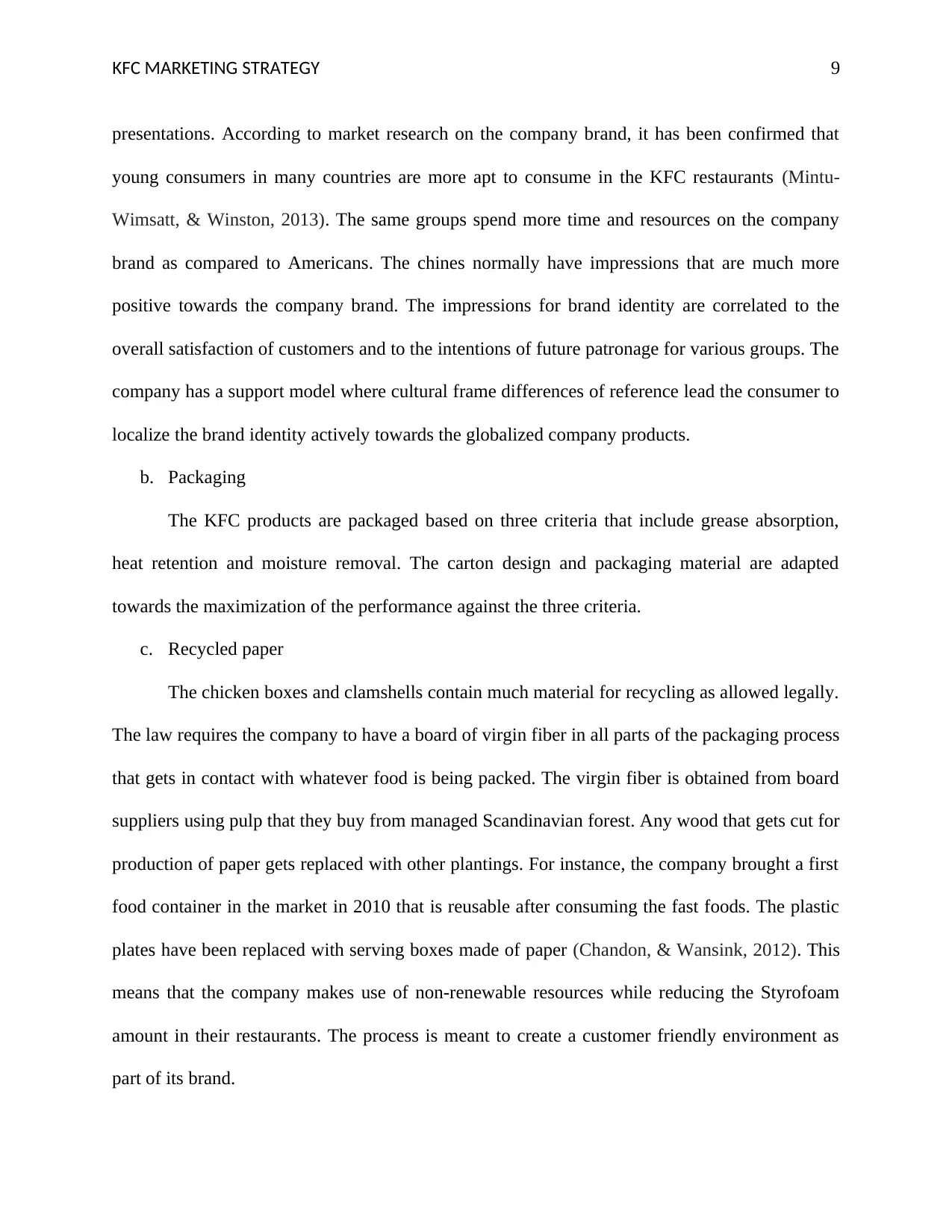
KFC MARKETING STRATEGY 9
presentations. According to market research on the company brand, it has been confirmed that
young consumers in many countries are more apt to consume in the KFC restaurants (Mintu-
Wimsatt, & Winston, 2013). The same groups spend more time and resources on the company
brand as compared to Americans. The chines normally have impressions that are much more
positive towards the company brand. The impressions for brand identity are correlated to the
overall satisfaction of customers and to the intentions of future patronage for various groups. The
company has a support model where cultural frame differences of reference lead the consumer to
localize the brand identity actively towards the globalized company products.
b. Packaging
The KFC products are packaged based on three criteria that include grease absorption,
heat retention and moisture removal. The carton design and packaging material are adapted
towards the maximization of the performance against the three criteria.
c. Recycled paper
The chicken boxes and clamshells contain much material for recycling as allowed legally.
The law requires the company to have a board of virgin fiber in all parts of the packaging process
that gets in contact with whatever food is being packed. The virgin fiber is obtained from board
suppliers using pulp that they buy from managed Scandinavian forest. Any wood that gets cut for
production of paper gets replaced with other plantings. For instance, the company brought a first
food container in the market in 2010 that is reusable after consuming the fast foods. The plastic
plates have been replaced with serving boxes made of paper (Chandon, & Wansink, 2012). This
means that the company makes use of non-renewable resources while reducing the Styrofoam
amount in their restaurants. The process is meant to create a customer friendly environment as
part of its brand.
presentations. According to market research on the company brand, it has been confirmed that
young consumers in many countries are more apt to consume in the KFC restaurants (Mintu-
Wimsatt, & Winston, 2013). The same groups spend more time and resources on the company
brand as compared to Americans. The chines normally have impressions that are much more
positive towards the company brand. The impressions for brand identity are correlated to the
overall satisfaction of customers and to the intentions of future patronage for various groups. The
company has a support model where cultural frame differences of reference lead the consumer to
localize the brand identity actively towards the globalized company products.
b. Packaging
The KFC products are packaged based on three criteria that include grease absorption,
heat retention and moisture removal. The carton design and packaging material are adapted
towards the maximization of the performance against the three criteria.
c. Recycled paper
The chicken boxes and clamshells contain much material for recycling as allowed legally.
The law requires the company to have a board of virgin fiber in all parts of the packaging process
that gets in contact with whatever food is being packed. The virgin fiber is obtained from board
suppliers using pulp that they buy from managed Scandinavian forest. Any wood that gets cut for
production of paper gets replaced with other plantings. For instance, the company brought a first
food container in the market in 2010 that is reusable after consuming the fast foods. The plastic
plates have been replaced with serving boxes made of paper (Chandon, & Wansink, 2012). This
means that the company makes use of non-renewable resources while reducing the Styrofoam
amount in their restaurants. The process is meant to create a customer friendly environment as
part of its brand.
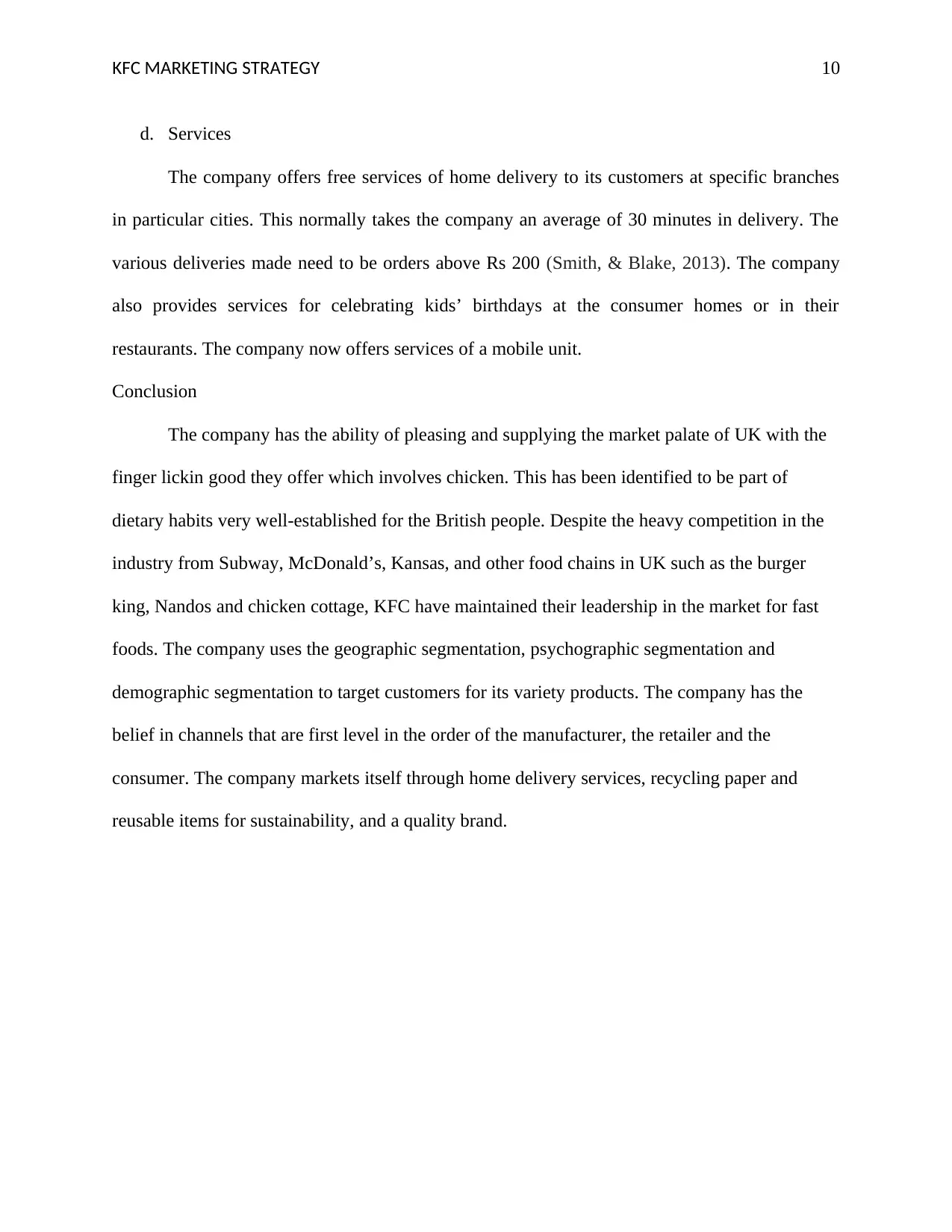
KFC MARKETING STRATEGY 10
d. Services
The company offers free services of home delivery to its customers at specific branches
in particular cities. This normally takes the company an average of 30 minutes in delivery. The
various deliveries made need to be orders above Rs 200 (Smith, & Blake, 2013). The company
also provides services for celebrating kids’ birthdays at the consumer homes or in their
restaurants. The company now offers services of a mobile unit.
Conclusion
The company has the ability of pleasing and supplying the market palate of UK with the
finger lickin good they offer which involves chicken. This has been identified to be part of
dietary habits very well-established for the British people. Despite the heavy competition in the
industry from Subway, McDonald’s, Kansas, and other food chains in UK such as the burger
king, Nandos and chicken cottage, KFC have maintained their leadership in the market for fast
foods. The company uses the geographic segmentation, psychographic segmentation and
demographic segmentation to target customers for its variety products. The company has the
belief in channels that are first level in the order of the manufacturer, the retailer and the
consumer. The company markets itself through home delivery services, recycling paper and
reusable items for sustainability, and a quality brand.
d. Services
The company offers free services of home delivery to its customers at specific branches
in particular cities. This normally takes the company an average of 30 minutes in delivery. The
various deliveries made need to be orders above Rs 200 (Smith, & Blake, 2013). The company
also provides services for celebrating kids’ birthdays at the consumer homes or in their
restaurants. The company now offers services of a mobile unit.
Conclusion
The company has the ability of pleasing and supplying the market palate of UK with the
finger lickin good they offer which involves chicken. This has been identified to be part of
dietary habits very well-established for the British people. Despite the heavy competition in the
industry from Subway, McDonald’s, Kansas, and other food chains in UK such as the burger
king, Nandos and chicken cottage, KFC have maintained their leadership in the market for fast
foods. The company uses the geographic segmentation, psychographic segmentation and
demographic segmentation to target customers for its variety products. The company has the
belief in channels that are first level in the order of the manufacturer, the retailer and the
consumer. The company markets itself through home delivery services, recycling paper and
reusable items for sustainability, and a quality brand.
Secure Best Marks with AI Grader
Need help grading? Try our AI Grader for instant feedback on your assignments.
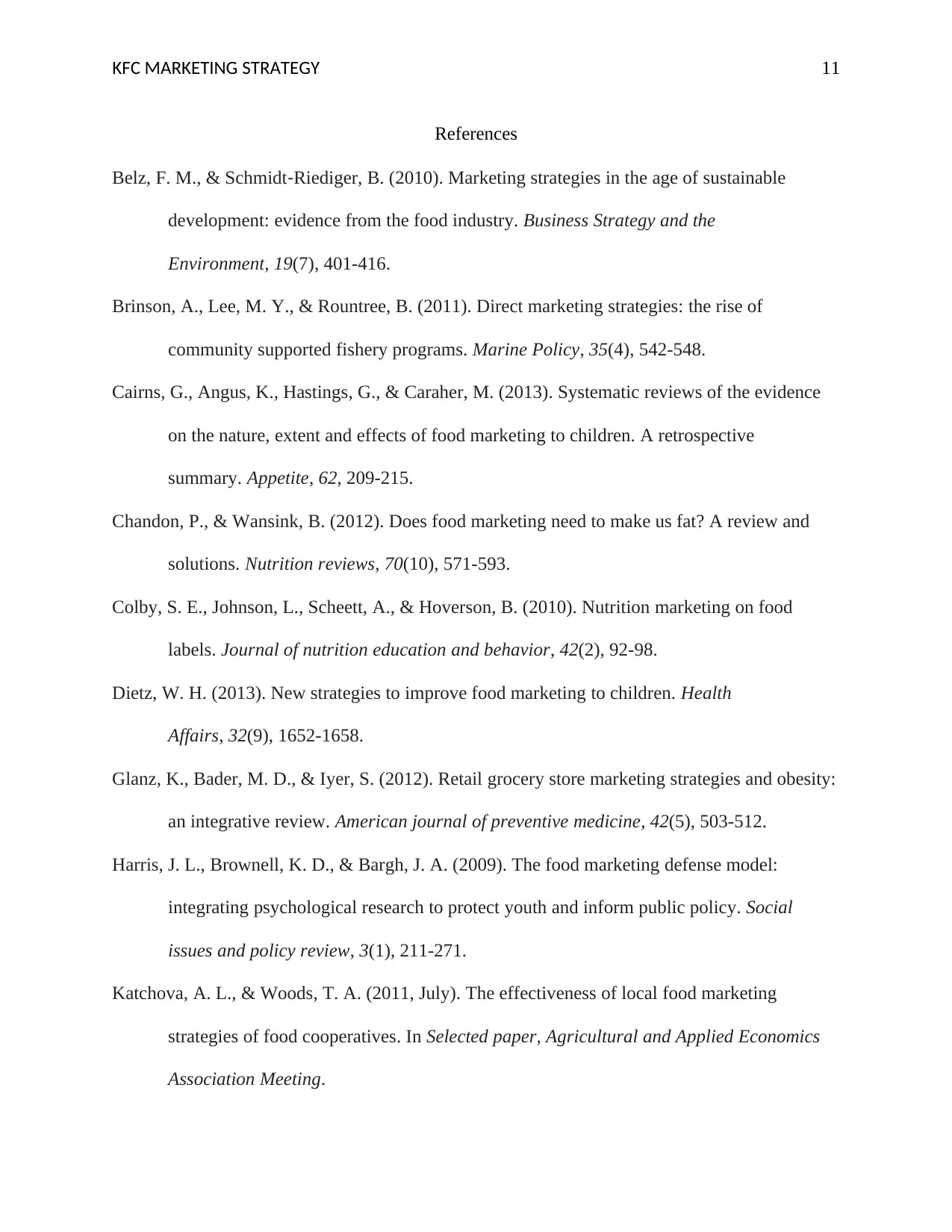
KFC MARKETING STRATEGY 11
References
Belz, F. M., & Schmidt‐Riediger, B. (2010). Marketing strategies in the age of sustainable
development: evidence from the food industry. Business Strategy and the
Environment, 19(7), 401-416.
Brinson, A., Lee, M. Y., & Rountree, B. (2011). Direct marketing strategies: the rise of
community supported fishery programs. Marine Policy, 35(4), 542-548.
Cairns, G., Angus, K., Hastings, G., & Caraher, M. (2013). Systematic reviews of the evidence
on the nature, extent and effects of food marketing to children. A retrospective
summary. Appetite, 62, 209-215.
Chandon, P., & Wansink, B. (2012). Does food marketing need to make us fat? A review and
solutions. Nutrition reviews, 70(10), 571-593.
Colby, S. E., Johnson, L., Scheett, A., & Hoverson, B. (2010). Nutrition marketing on food
labels. Journal of nutrition education and behavior, 42(2), 92-98.
Dietz, W. H. (2013). New strategies to improve food marketing to children. Health
Affairs, 32(9), 1652-1658.
Glanz, K., Bader, M. D., & Iyer, S. (2012). Retail grocery store marketing strategies and obesity:
an integrative review. American journal of preventive medicine, 42(5), 503-512.
Harris, J. L., Brownell, K. D., & Bargh, J. A. (2009). The food marketing defense model:
integrating psychological research to protect youth and inform public policy. Social
issues and policy review, 3(1), 211-271.
Katchova, A. L., & Woods, T. A. (2011, July). The effectiveness of local food marketing
strategies of food cooperatives. In Selected paper, Agricultural and Applied Economics
Association Meeting.
References
Belz, F. M., & Schmidt‐Riediger, B. (2010). Marketing strategies in the age of sustainable
development: evidence from the food industry. Business Strategy and the
Environment, 19(7), 401-416.
Brinson, A., Lee, M. Y., & Rountree, B. (2011). Direct marketing strategies: the rise of
community supported fishery programs. Marine Policy, 35(4), 542-548.
Cairns, G., Angus, K., Hastings, G., & Caraher, M. (2013). Systematic reviews of the evidence
on the nature, extent and effects of food marketing to children. A retrospective
summary. Appetite, 62, 209-215.
Chandon, P., & Wansink, B. (2012). Does food marketing need to make us fat? A review and
solutions. Nutrition reviews, 70(10), 571-593.
Colby, S. E., Johnson, L., Scheett, A., & Hoverson, B. (2010). Nutrition marketing on food
labels. Journal of nutrition education and behavior, 42(2), 92-98.
Dietz, W. H. (2013). New strategies to improve food marketing to children. Health
Affairs, 32(9), 1652-1658.
Glanz, K., Bader, M. D., & Iyer, S. (2012). Retail grocery store marketing strategies and obesity:
an integrative review. American journal of preventive medicine, 42(5), 503-512.
Harris, J. L., Brownell, K. D., & Bargh, J. A. (2009). The food marketing defense model:
integrating psychological research to protect youth and inform public policy. Social
issues and policy review, 3(1), 211-271.
Katchova, A. L., & Woods, T. A. (2011, July). The effectiveness of local food marketing
strategies of food cooperatives. In Selected paper, Agricultural and Applied Economics
Association Meeting.
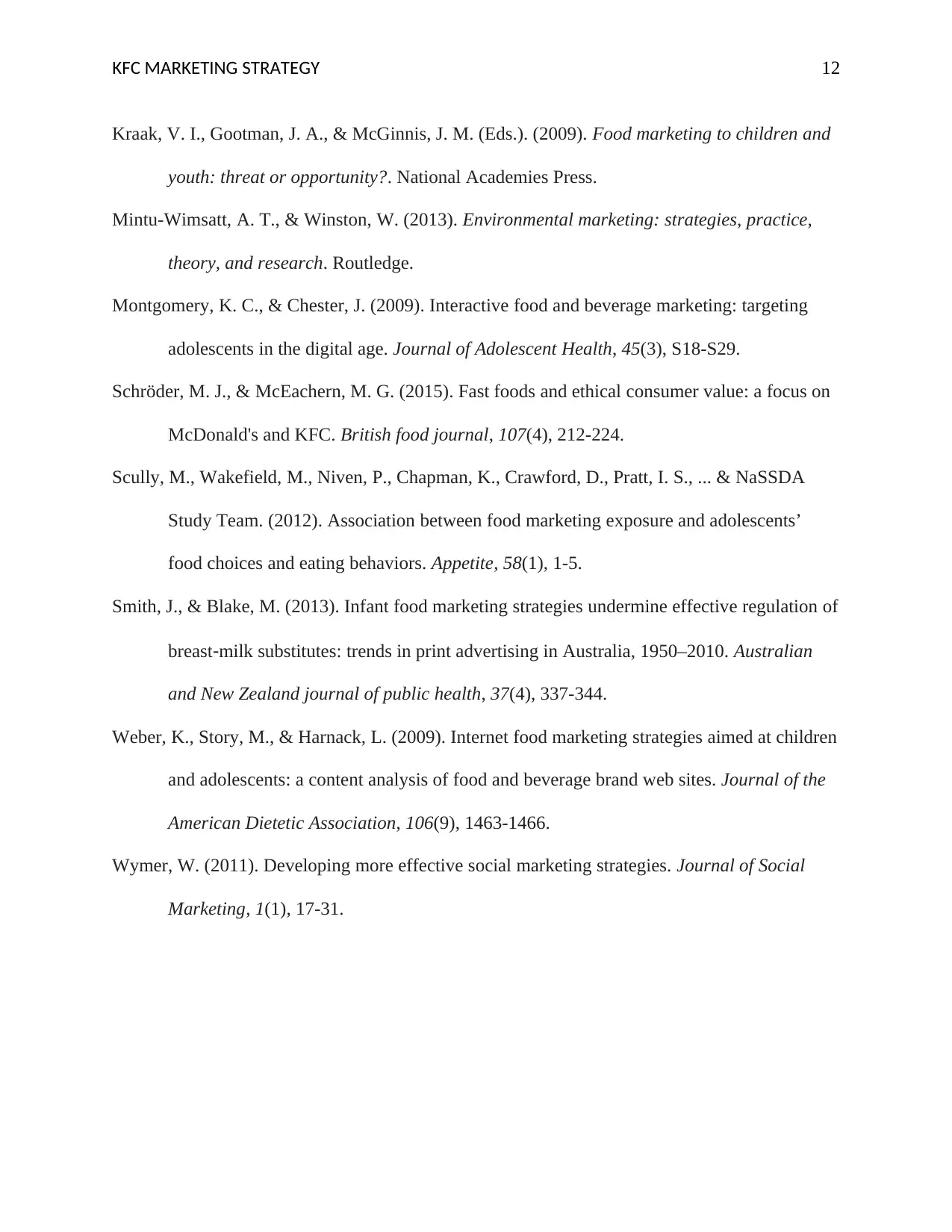
KFC MARKETING STRATEGY 12
Kraak, V. I., Gootman, J. A., & McGinnis, J. M. (Eds.). (2009). Food marketing to children and
youth: threat or opportunity?. National Academies Press.
Mintu-Wimsatt, A. T., & Winston, W. (2013). Environmental marketing: strategies, practice,
theory, and research. Routledge.
Montgomery, K. C., & Chester, J. (2009). Interactive food and beverage marketing: targeting
adolescents in the digital age. Journal of Adolescent Health, 45(3), S18-S29.
Schröder, M. J., & McEachern, M. G. (2015). Fast foods and ethical consumer value: a focus on
McDonald's and KFC. British food journal, 107(4), 212-224.
Scully, M., Wakefield, M., Niven, P., Chapman, K., Crawford, D., Pratt, I. S., ... & NaSSDA
Study Team. (2012). Association between food marketing exposure and adolescents’
food choices and eating behaviors. Appetite, 58(1), 1-5.
Smith, J., & Blake, M. (2013). Infant food marketing strategies undermine effective regulation of
breast‐milk substitutes: trends in print advertising in Australia, 1950–2010. Australian
and New Zealand journal of public health, 37(4), 337-344.
Weber, K., Story, M., & Harnack, L. (2009). Internet food marketing strategies aimed at children
and adolescents: a content analysis of food and beverage brand web sites. Journal of the
American Dietetic Association, 106(9), 1463-1466.
Wymer, W. (2011). Developing more effective social marketing strategies. Journal of Social
Marketing, 1(1), 17-31.
Kraak, V. I., Gootman, J. A., & McGinnis, J. M. (Eds.). (2009). Food marketing to children and
youth: threat or opportunity?. National Academies Press.
Mintu-Wimsatt, A. T., & Winston, W. (2013). Environmental marketing: strategies, practice,
theory, and research. Routledge.
Montgomery, K. C., & Chester, J. (2009). Interactive food and beverage marketing: targeting
adolescents in the digital age. Journal of Adolescent Health, 45(3), S18-S29.
Schröder, M. J., & McEachern, M. G. (2015). Fast foods and ethical consumer value: a focus on
McDonald's and KFC. British food journal, 107(4), 212-224.
Scully, M., Wakefield, M., Niven, P., Chapman, K., Crawford, D., Pratt, I. S., ... & NaSSDA
Study Team. (2012). Association between food marketing exposure and adolescents’
food choices and eating behaviors. Appetite, 58(1), 1-5.
Smith, J., & Blake, M. (2013). Infant food marketing strategies undermine effective regulation of
breast‐milk substitutes: trends in print advertising in Australia, 1950–2010. Australian
and New Zealand journal of public health, 37(4), 337-344.
Weber, K., Story, M., & Harnack, L. (2009). Internet food marketing strategies aimed at children
and adolescents: a content analysis of food and beverage brand web sites. Journal of the
American Dietetic Association, 106(9), 1463-1466.
Wymer, W. (2011). Developing more effective social marketing strategies. Journal of Social
Marketing, 1(1), 17-31.
1 out of 12
Related Documents
Your All-in-One AI-Powered Toolkit for Academic Success.
+13062052269
info@desklib.com
Available 24*7 on WhatsApp / Email
![[object Object]](/_next/static/media/star-bottom.7253800d.svg)
Unlock your academic potential
© 2024 | Zucol Services PVT LTD | All rights reserved.





